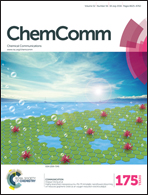Host–guest architectures with a surface confined imine covalent organic framework as two-dimensional host networks†
Abstract
A two-dimensional covalent organic framework (2D COF), synthesized on a highly oriented pyrolytic graphite (HOPG) surface with benzene-1,3,5-tricarbaldehyde and p-phenylenediamine as the precursors, is used as a host to accommodate three guest molecules, coronene, copper phthalocyanine (CuPc), and fluorine-substituted copper phthalocyanine (F16CuPc). The host–guest interaction and dynamic behavior were investigated by scanning tunneling microscopy and density functional theory.


 Please wait while we load your content...
Please wait while we load your content...